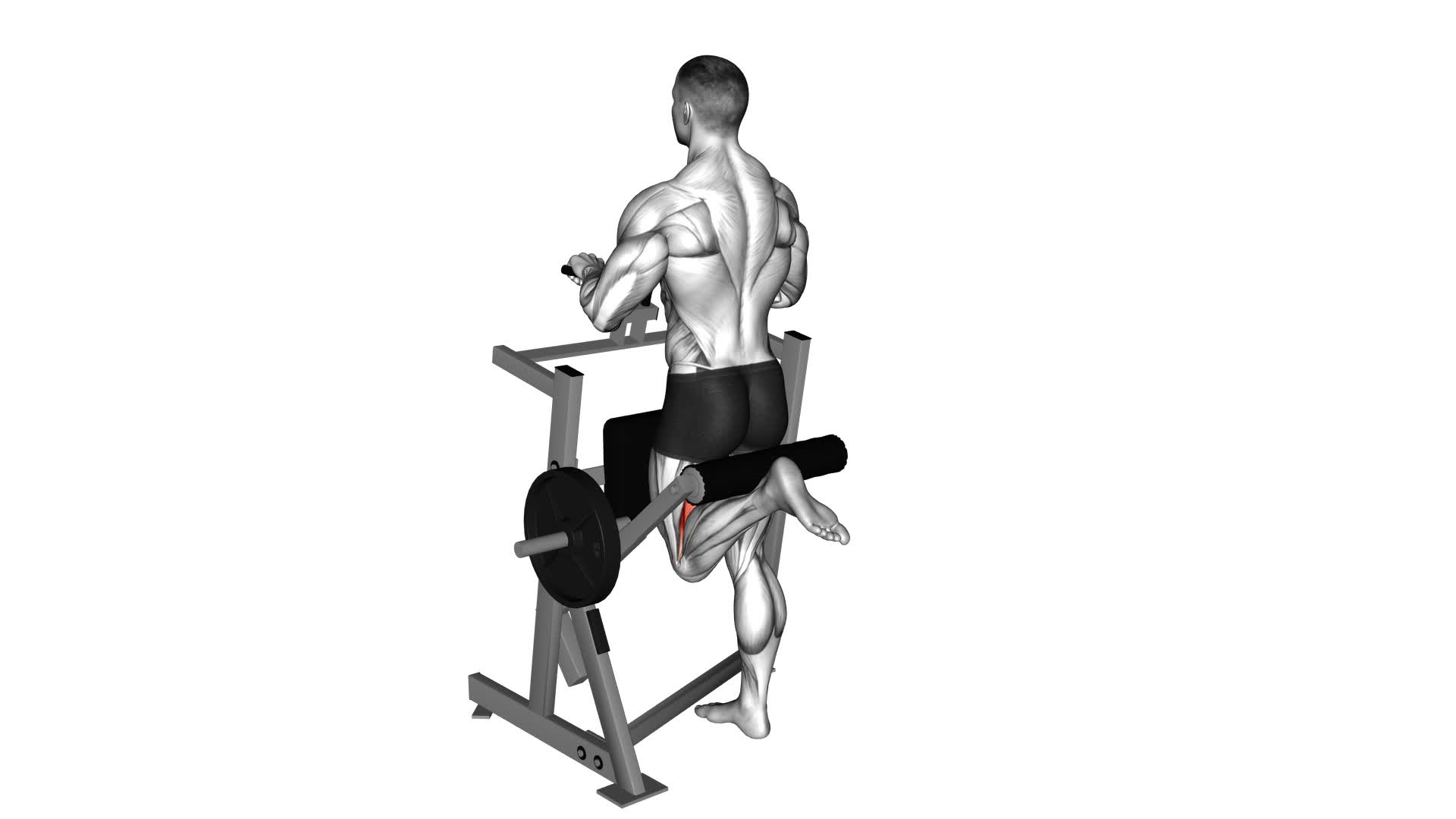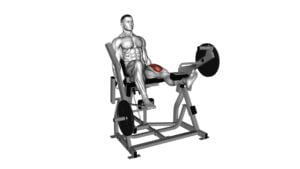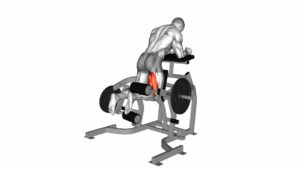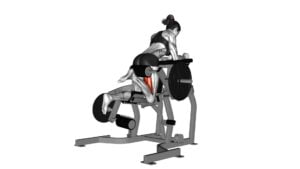Lever Standing Single Leg Curl (Plate Loaded) – Video Exercise Guide & Tips

Are you looking to strengthen your leg muscles and improve your overall fitness?
Watch This Exercise Video
The Lever Standing Single Leg Curl is a great exercise for targeting and toning your hamstrings.
In this video exercise guide, we'll show you the proper set up and machine adjustment, along with the technique and form for maximum results.
Avoid common mistakes and discover variations and progressions to challenge yourself.
Get ready to take your leg workout to the next level!
Key Takeaways
- Targets and tones hamstrings
- Improves hamstring strength and stability
- Helps prevent injuries
- Enhances lower body stability
Benefits of Lever Standing Single Leg Curl
Improve your hamstring strength and stability with the lever standing single leg curl. This exercise is a great way to target and strengthen the muscles in the back of your thighs. By incorporating this exercise into your workout routine, you can experience improved hamstring strength, which is essential for various activities such as running, jumping, and even walking.
The lever standing single leg curl is also beneficial for injury prevention. Strong hamstrings can help stabilize the knee joint and reduce the risk of injuries, especially during activities that involve sudden changes in direction or intense physical exertion. Additionally, by strengthening your hamstrings, you can improve your overall lower body stability, which is crucial for maintaining proper posture and preventing imbalances or compensations that can lead to injuries.
Transitioning into the subsequent section about proper set up and machine adjustment, it's important to ensure that you set up the lever standing single leg curl machine correctly to maximize its benefits and avoid any potential injuries.
Proper Set Up and Machine Adjustment
To ensure maximum benefits and prevent potential injuries, it's important to properly set up and adjust the lever standing single leg curl machine. Follow these set up instructions and tips to ensure a safe and effective workout:
- Adjust the footpad: Start by adjusting the footpad height according to your leg length. The pad should be positioned just above your ankle, allowing for a full range of motion without any discomfort.
- Set the resistance: Choose an appropriate weight that challenges your muscles without compromising form. Start with a lighter weight and gradually increase as you become more comfortable with the exercise.
- Position yourself correctly: Stand facing the lever machine with your back straight and your feet hip-width apart. Place one leg on the footpad, ensuring that your knee is aligned with the pivot point of the machine.
- Maintain proper form: As you perform the exercise, keep your core engaged and your upper body stable. Slowly curl your leg towards your glutes, focusing on contracting your hamstrings. Pause for a moment at the top of the movement before lowering your leg back to the starting position.
Technique and Form for Maximum Results
Continuing with the proper set up and machine adjustment, ensure you maintain correct technique and form for maximum results during the lever standing single leg curl exercise.
This exercise is one of the most effective hamstring exercises, targeting the muscles at the back of your thighs.
To ensure proper muscle activation during leg curls, start by standing upright with your feet shoulder-width apart. Place one foot on the lever pad and adjust the pad so that it rests just above your ankle. Engage your core and maintain a slight bend in your knee.
As you curl your leg up, focus on squeezing your hamstring muscles, keeping your upper body stable and your hips square. Avoid using momentum or swinging your leg up. Slowly lower your leg back to the starting position, controlling the movement throughout.
By maintaining proper technique and form, you'll optimize the benefits of this exercise and prevent any potential injuries.
Now, let's move on to the next section and discuss common mistakes to avoid.
Common Mistakes to Avoid
To avoid common mistakes, focus on maintaining proper technique and form during the lever standing single leg curl exercise. Here are some common mistakes to avoid and tips for proper execution:
- Using too much weight: It can be tempting to increase the weight to challenge yourself, but using too much weight can compromise your form and increase the risk of injury. Start with a manageable weight and gradually increase as you build strength and improve your form.
- Swinging your leg: To get a full range of motion and target the hamstring muscles effectively, it's important to control the movement and avoid swinging your leg. Keep your core engaged and focus on using your hamstring muscles to curl your leg towards your glutes.
- Rounding your back: Maintaining a neutral spine is crucial during this exercise. Avoid rounding your back as it can put unnecessary stress on your spine and reduce the effectiveness of the exercise. Keep your chest up and shoulders back throughout the movement.
- Not fully extending your leg: Make sure to fully extend your leg at the starting position of each repetition. This will ensure that you're engaging your hamstring muscles fully and getting the most out of the exercise.
Variations and Progressions to Challenge Yourself
Try incorporating variations and progressions into your lever standing single leg curl routine to challenge yourself and keep your workouts interesting.
Advanced modifications can help you target specific muscle groups and increase the intensity of the exercise.
One advanced modification is the use of resistance bands. Attach one end of the band to the lever and the other end to a stable object, such as a squat rack or a wall. This will add resistance throughout the entire range of motion, making the exercise more challenging.
Another advanced modification is to perform the exercise on an unstable surface, such as a Bosu ball or a balance board. This will require more core stability and balance, increasing the activation of your muscles.
To further challenge yourself, you can incorporate muscle activation techniques, such as isometric holds. Instead of performing a standard leg curl, pause at the top of the movement and hold for a few seconds before slowly lowering the lever back down. This will increase the time under tension and engage your muscles even more.
Remember to always maintain proper form and listen to your body.
Start with lighter weights and gradually increase the intensity as you become more comfortable with the variations and progressions.
Frequently Asked Questions
How Many Sets and Reps Should I Do for the Lever Standing Single Leg Curl?
To progress in the lever standing single leg curl, start with 2-3 sets of 8-12 reps per leg. Increase the weight gradually as you get stronger.
Avoid common mistakes like using momentum or arching your back. Keep your core engaged and maintain control throughout the movement.
Don't rush through the exercise. Focus on squeezing your hamstring as you curl your leg up.
Remember to stretch and warm up before starting the exercise.
Can Beginners Perform the Lever Standing Single Leg Curl Exercise?
Yes, beginners can perform the lever standing single leg curl exercise. It's important to start with lighter weights and focus on proper form.
If you find it challenging, you can modify the exercise by using both legs instead of one. Alternatively, you can try other exercises that target the same muscle groups, such as seated leg curls or glute bridges.
Remember to consult with a fitness professional to ensure proper technique and avoid injury.
Is It Necessary to Use a Weight Plate for This Exercise, or Can I Use Other Equipment?
You don't necessarily have to use a weight plate for the lever standing single leg curl exercise. There are different variations of this exercise that you can try, which don't require a weight plate.
For example, you can use resistance bands or ankle weights to add resistance instead. These alternatives can still effectively target and strengthen your hamstring muscles.
How Often Should I Include the Lever Standing Single Leg Curl in My Workout Routine?
To determine the workout frequency of the lever standing single leg curl, it's important to consider your fitness goals and overall workout routine.
This exercise targets the hamstring muscles and can be included 1-3 times per week. However, it's essential to listen to your body and avoid overtraining.
To track progress, monitor the weight and repetitions you can comfortably perform, and aim to gradually increase these numbers over time.
What Muscles Does the Lever Standing Single Leg Curl Primarily Target?
The lever standing single leg curl primarily targets your hamstring muscles. By incorporating this exercise into your leg workout routine, you can benefit from increased hamstring strength and stability.
For different fitness levels, there are variations and modifications available. Beginners can start with bodyweight only or use a lighter load, while advanced individuals can increase the weight or use a resistance band for added intensity. These modifications help cater to your specific fitness level and goals.
Conclusion
In conclusion, the lever standing single leg curl exercise is an effective way to target and strengthen your hamstrings. By properly setting up and adjusting the machine, using the correct technique and form, and avoiding common mistakes, you can maximize your results.
Additionally, there are variations and progressions available to challenge yourself as you progress in your fitness journey. Incorporate this exercise into your routine for stronger and more defined hamstrings.

Author
Years ago, the spark of my life’s passion ignited in my mind the moment I stepped into the local gym for the first time. The inaugural bead of perspiration, the initial endeavor, the very first surge of endorphins, and a sense of pride that washed over me post-workout marked the beginning of my deep-seated interest in strength sports, fitness, and sports nutrition. This very curiosity blossomed rapidly into a profound fascination, propelling me to earn a Master’s degree in Physical Education from the Academy of Physical Education in Krakow, followed by a Sports Manager diploma from the Jagiellonian University. My journey of growth led me to gain more specialized qualifications, such as being a certified personal trainer with a focus on sports dietetics, a lifeguard, and an instructor for wellness and corrective gymnastics. Theoretical knowledge paired seamlessly with practical experience, reinforcing my belief that the transformation of individuals under my guidance was also a reflection of my personal growth. This belief holds true even today. Each day, I strive to push the boundaries and explore new realms. These realms gently elevate me to greater heights. The unique combination of passion for my field and the continuous quest for growth fuels my drive to break new ground.







